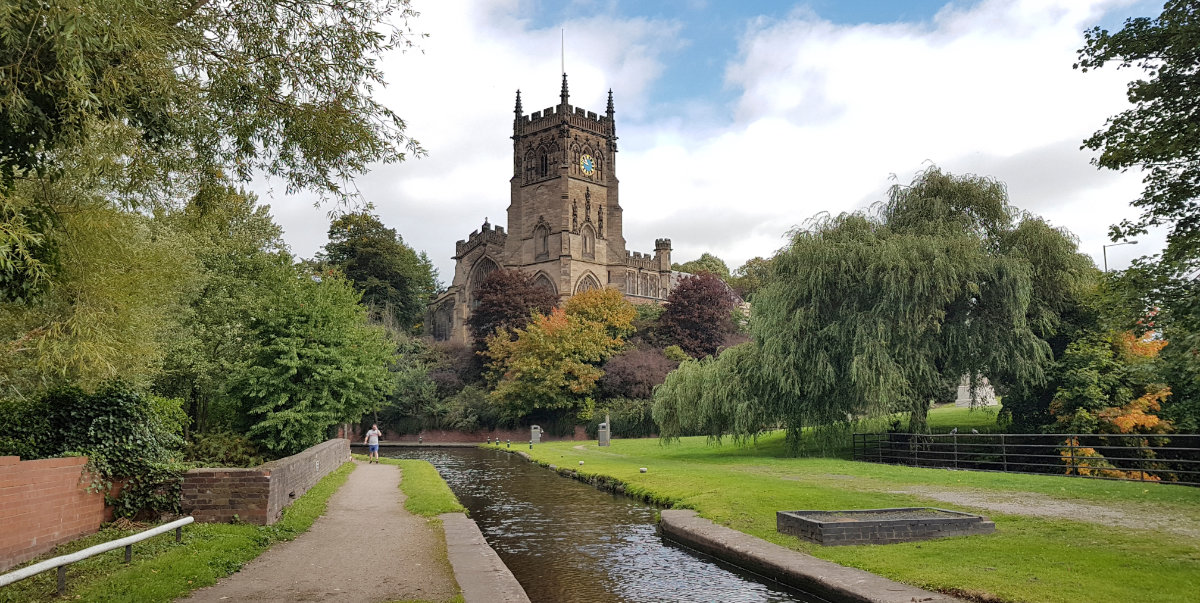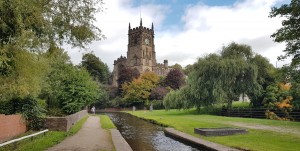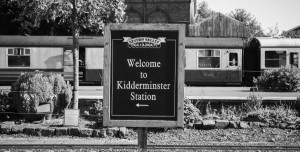
Kidderminster Everything you ever wanted to know about this Worcestershire but were too scared to ask!
The Worcestershire town of Kidderminster has one of the more interesting names in England. Nobody knows how to spell it and, of those that do, nobody seems to be able to explain its odd name… at least not the ‘Kidder’ part.
Of course, here at Five Minutes Spare we couldn’t just let that rest, we had to do some digging! Where did the town get its strange name from and what has happened there since?

Image: snapvision/Suutterstock.com
You never know. Kidderminster could become your staycation destination of a lifetime this year. Read on and see.
Kidderminster’s Junior Years
Kidderminster probably arose due of its strategic position – between the main thoroughfares that lead to Birmingham, Worcester, Dudley, and other towns.
The earliest reference to the habitation of the area goes to the charter King Aethelbald of Mercia granted to a monastery, up until recently believed to have been nearby, but now figured to be the town itself. This would explain the ‘Minster’ part of the name, although the Kidderminster name was not used in official documents up until the 15th century.
Before any of this, Kidderminster was the land belonging to the Husmerae, who were an ancient tribe that lived on the British Isles even before the Romans showed up. There are Iron Age settlements in the lands around the town, but the nearest Roman settlements have been recorded in Worcester City. Nevertheless, the invading Romans may well have had a few villas in the area, circa 80AD.
After the Romans left, the history books record the land was gifted by Offa of Mercia in 781 to a Bishop, who went about restoring the monastery there. The proximity of the River Stour may have made them a target for the Vikings, but under Danelaw, they would be directly under the Danes’ control. This stopped the killing and saw the Danes successfully integrate with the people here.
Britannica has the passage slightly differently. They record Stour-in-Usmere as the town’s original name before any bishops got near it. Stour belonged to King Aethelbald of Mercia. Next, it passed to the Bishop of Worcester, then to Cenwulf, the later king of Mercia in 816. According to them, it remained a royal country house until the reign of Henry II in the 12th century.
Medieval Times in Kidderminster
By the time of the Domesday Survey conducted 20 years after the Normans invaded in 1066, Kidderminster was an established settlement. Regardless of which king was befriending which bishop, we can always count on the Open Domesday resource to help us get to the bottom of it.
The survey records Kidderminster as being only 3.9 households strong – but it held 21 villages, 38 smallholders, and 8 slaves recorded as four male and four female. These high numbers would be explained if the 3.9 households mentioned were big stately homes. Especially if this was a royal country home.
As well as the people, early medieval Kidderminster had 45.5 ploughlands, 3 lord’s teams and 22.5 men’s plough teams to work those fields, 4 leagues of woodland, 3 mills, 1 fishery and even two salt houses. In the days before fridge-freezers and canning, we had to make do with salt preservation.
In 1156, Henry II gave his manor to his steward for a few years. After this, it started to grow at a steady rate. By 1228 the settlement was so large that a charter for a market there was granted. This charter was built upon in 1240 when they would have been allowed to hold an annual fayre.
During the 1500s, there was a castle in the area, which was just a fortified house. Most of it is now gone although you can still see a tower of it on the south side of the Stour. The cloth industry kicked off here in that same century since they were perfectly placed to use the water to help the weavers. In 1540 it was noted as a place that produced clothing. Over the years it would produce all manner of fabrics, from sailcloths to silks. The main business of the town from the 16th century onwards was in dying, leatherworking, weaving, tailor, shoemaking and haberdashery production.
Let’s take a natural stopping point break there and inject some fun facts into this historic tale.
Fun Facts About Kidderminster
You don’t get to where we have gotten in the tours of English towns and cities listings by ignoring the trivia round. Here are the top Five Minute Spare favourite facts about Kidderminster:
- Carpet making was so popular in the 19th Century that when the town got its own local newspaper in 1870 it was named “The Kidderminster Shuttle“. Unlike carpet making it is still going strong today.
- The man who invented the first sticky stamp for the Royal Mail came from this town. He was called Sir Rowland Hill. He designed the stamp in the 1830s and it was known as the ‘penny black stamp’. Up until then, postage was paid for by the recipient.
- A man from Kidderminster was put to trial in the witch trials of Worcester, sometime around 1661. He was put through the trial by water and drowned in the Severn, after being dragged to Worcester city to stand trial. The Birmingham Live journal reports that his crime was ‘having 5 teats’.
- Kidderminster is the largest town in the Wyre Forest District. As mentioned in the Domesday Survey, there’s still a lot of woodlands out there to explore.
- Nearby Belbroughton was the world’s leading producer of Scythes at one point.
We hope that’s enough to at least whet your appetites with regards to fun things to find out about Kidderminster. If not, that’s fine, but let’s ignore it and get back to the history.
The Industrial Era in Kidderminster
The first carpet was woven in Kidderminster in 1735 by a man named John Pearsall. It is estimated that this would have been possible due to the early arrival of the cloth industry here. Weaving took hold of Kidderminster long before the Industrial Revolution brought silk and cotton to other towns. Unfortunately, carpet making didn’t survive past the 1970s… but it had a fair run.
By 1670, Kidderminster had a cloth industry so well thriving that they were allowed their own Guild. There were some 4,000 members including weavers and spinners seven years later. The Huguenots – weavers of international renown in 1685, sent even more weavers to the heart of Kidderminster, after Louis XIV threw them out of France. They brought secrets of the trade that they shared with the merchants in Britain. France was mad but we got better fabrics. The Huguenots went on to settle in Worcester, but not without sharing secrets as they passed on through.
Carpets Everywhere
Carpet weaving took off in the beginning of the Industrial era. It was the primary output of the town for decades, sustaining them even after the eventual decline of cotton weaving. The Staffordshire and Worcestershire Canal arrived in the 1770s, bringing with it more trade routes and better carpet sales. The railway didn’t get here until 1852 – that’s about 7 years later than when it arrived further south – perhaps owing to the town’s small size.
By 1828, mills had changed the way weavers produced fabric, although the guild still gave them some protection. There were some 2000 looms in town noted in 1828. After the looms were broken down for a few weeks in the same century, riots broke out among workers who couldn’t feed themselves. A recorded £3,000 damage was done overnight – but let’s remember that history was not recorded by the working man, but by the guy writing his cheques.
The town hall, still in use today, was built in 1877. There are two churches in town that precede this in age. One was built in 1824 (St. George’s) and one in 1843 (St. John’s). A military institution has existed in the town for hundreds of years but in the late 1800s, it was finally turned into a military HQ.
Modern Kidderminster
Modern Kidderminster has seen two separate World Wars, and yet new housing wasn’t added until the soldiers returned from the first one. During WWII, the local carpet factory was requisitioned and turned towards making blankets for the soldiers. The town escaped most of the blitz, too, since it was considered too rural. There are some fascinating old tunnels under the north of the town towards the Blakeshall Estate that would have been used in the event of an air raid. They’re called the Drakelow Tunnels if anyone wants to look them up.
Since the end of the Second World War, the town has undergone significant changes. The end of the carpet industry meant the end of an era. The town has its own newspaper and a grant in 2004 funded the museum dedicated to carpet making in the town.
Nowadays, Kidderminster is known to be a historic town in rural Worcestershire. After all of that history, it has grown to have a population of 55 thousand people and is even its own borough. From the old kingdom of Mercia right down to the modern age, Kidderminster has seen such continuous occupation that we wouldn’t be surprised if there was a ghost on every street.
By all means, visit for a holiday, just don’t be surprised if you run into a few ghosties while you are there.
Let’s cover who you might meet down Tesco on a Friday night before we move on to the attractions of Kidderminster.
Famous People from Kidderminster
Almost all of the towns and cities we review here at Five Minutes Spare have famous people from them. Sometimes, you need to dig deep, but they’re always there. Let’s turn our gaze over Kidderminster’s famous faces and see if we need to bring our shovels.
Famous faces from Kidderminster include:
- Noah Cooke, who you haven’t heard of but who led a fascinating double life. Cooke was a weaver by day, just like his father was. By night, he wrote stacks of poetry. They nicknamed him the Weaver Poet, which is kind of romantic for a working man from Kidderminster.
- There are several smart cookies from this town. Experimental Physicist John Forgeham, an internationally acclaimed professor of art at Utah University Alvin Gittins, was born here.
- The cricketer Josh Haynes was from here.
- …oh, and let’s not forget Robert Plant, from Led Zeppelin, is from Kidderminster.
If you hang around that supermarket long enough, you never know who is likely to show up. Let’s just hope it’s not Noah Cooke. You can get a full list of historic famous figures from Kidderminster, here.
In the meantime, let’s get to the part you have all been waiting for… the attractions!
The Best Things to See and Do in Kidderminster
Whether you want to come for a holiday or whether you are just passing through, take the time to see the following sites.
Historic Sights and Landmarks
Those Drakelow Tunnels that we mentioned earlier make for a great excursion. School groups in the area are regularly found down there in the tunnels, taking advantage of the history of the military presence in the area as a teachable moment. The tunnels saw their most use during the Cold War, which is a little scary. The government really did think we were all going to bomb one another… so much so that they prepared for it in tunnel form. It’s eery down there and not for the claustrophobic.
Brinton Park has become somewhat of a local landmark. It has a skate park which was a long time coming and which is the perfect place to drop off the kids while you go shopping for the afternoon. Teens love it.
Outdoor Attractions
Part museum, part historic site, part landmark and part outdoor attraction, the steam train that runs through the Severn Valley is well worth taking a trip on. This is one of the best attractions in the area, allowing you to travel by steam train through some fantastic scenery. It’s by far the best way to enjoy a trip through the woodland.
For those that like to peruse gardens in summer and springtime, take a walk around the Stone House Cottage Gardens. This lovely nursery has all you need for a lovely Sunday morning stroll around the plants. They take care of the trees there too, which earns them extra points in our book. Enjoy it at all times of the year when this well-maintained outdoor treat looks great in all seasons.
If you have kids and are looking for something a little different, take them to the Gobbett Rare Breeds Farm & Nursery. This is a farm, not a petting zoo, but if you go at the right time of the year, they might let you see some baby animals. They specialise in rare breed preservation, so even though these birds and animals are born in captivity, it’s for the betterment of their species. Don’t be setting any free-thinking you are doing them a favour…
Galleries and Museums
You can’t come to Kidderminster and not take a look through the carpet museum. This awesome place holds the history of the ages, documenting the town’s long-standing history of association with the carpet and weaving industries. Cloth was important here, it’s only right that there is a building that celebrates this fact.
A second museum in the area comes in castle form. Hartlebury Castle is a part palace and part museum. This historic manor house was the home to the Bishops of Worcester for over a thousand years. It has since been restored and now makes for a beautiful place to visit for a day. They have a wonderful nature trail there that kids love to trek, and there are lots of nice hikes around the historic building, too.
Your third option in museums is the Kidderminster Railway Museum. The railway museum is a pleasant place, especially if you have young children. They will love being able to get on board the trains and learn about them. It’s a fun – but educational – day out… and it’s less creepy than the tunnels.
Sports and Recreation
As well as the skate park, you can head to the Pioneer centre for some outdoor fun. They cater to team-building events as well as to games and entertainment. They have massive grounds, but nobody is sure what they do in all that space.
The local football club is called the Kidderminster Harriers Football Club. They were established in 1886 and are still going strong. They play at Aggborough Stadium in town. They also have a rugby team in town, known as the Kidderminster Carolinas RFC.
Last but not least, those familiar with our articles will have noticed that all the English towns have at least one golf club. The bigger towns and cities can have as many as 6. Kidderminster has three within driving range (pardon the pun). You can pick up the club at Bewdley Pines Golf Club, have a swing at Kidderminster Golf Club, or take a leisurely 18 holes out at the Churchill and Blakedown Golf Club. Usually, you can pay for a round without needing a membership. Since Covid-19, many clubs have changed their rules on how you pay for your game.
Shopping and Retail
Shopping at this end of Worcester tends to focus on plant life. As well as those nurseries and garden centres already mentioned, you can head to the Hodgehill Garden Centre, Stanley’s farm shop, or any other number of farms.
If you want some retail therapy, however, you must head to the local mall. Check out the Weaver’s Wharf Shopping Centre to fulfil both your clothing and grocery needs. Kidderminster also has its own market every Thursday in the town centre, mostly selling the awesome fresh produce from the surrounding countryside.
Other Notable Attractions in Kidderminster
We couldn’t cover as much as we wanted to in one place but there’s always more to see and do. If you have even more time to kill in Kidderminster, here are some more suggestions on how to do so:
- If you enjoy a little antiquing, don’t forget to pop into Remade2Vintage. This little market has all manner of interesting items, all of which have been preloved.
- On the subject of garden centres, there’s also the Whitlenge Garden Centre and Tea Rooms, popular for a good scone.
- Fishermen can have fun here too, with the Moorlands Farm Coarse Fisheries nearby to town. Pack that rod and prepare for all weathers.
- The Wyre Forest Glades Leisure Centre has a good gym you can work out in, and you might even be able to leave the kids in the swimming pool while you get a coffee.
- This is a strange one, but there is a hidden museum in Kidderminster. Check the Military Wireless Museum put. It’s just full of old military radios…
- Kidderminster also has its own theatre. Check out the Rose
Theatre if you want to catch a show.
As you can see, there is no end of things to do in the lovely town of Kidderminster. The local area is teeming with garden centres. Take advantage and have your fill of scones.
How to Get to Kidderminster?

Image: Michael715/Shutterstock.com
Before you all rush off and get lost somewhere up the M1, let’s give you some directions.
By Road
Follow the AA56 southeast out of Birmingham.
By Rail
Aim for Kidderminster town train station which is within an hour of Birmingham.
By Air
Birmingham Airport isn’t far away.
By Sea
Alas, unless you can sail the River Stour, you are lost at sea for Kidderminster.
Got Five Minutes?
If you are still in need of visual stimulation, you can read all about other towns over on the Five Minutes Spare travel pages. You might even find your own hometown there. If not? Give it time. We’ll get to you.



